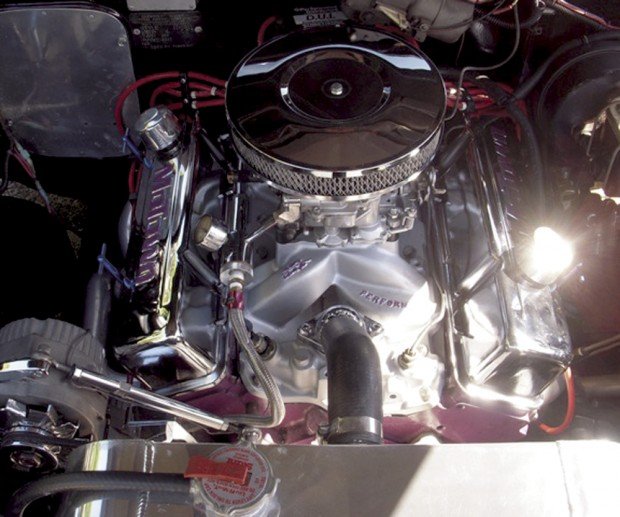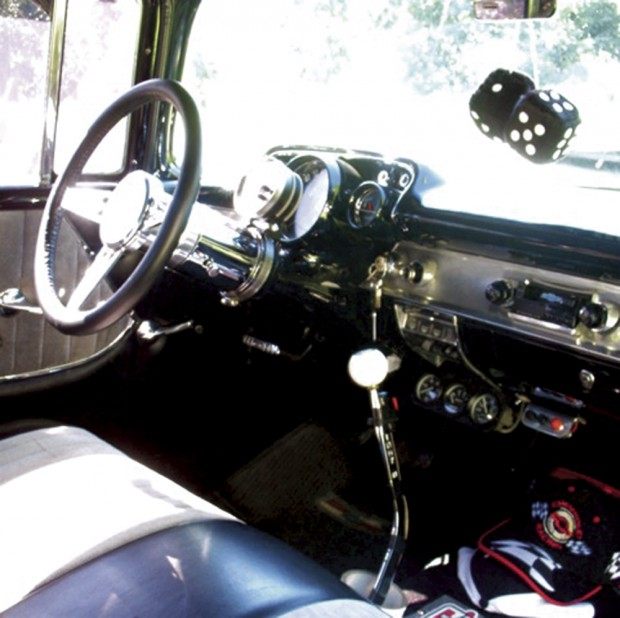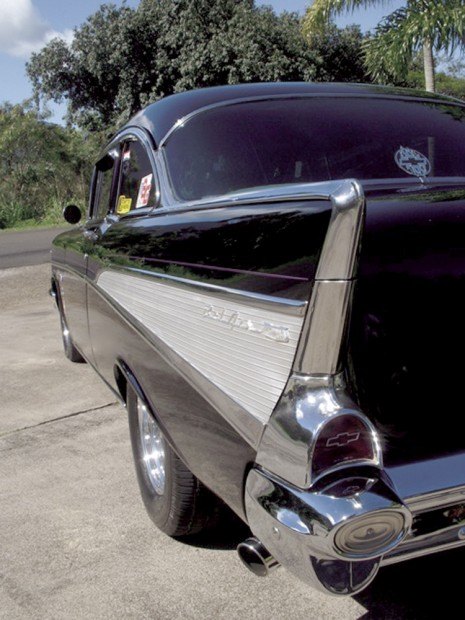Ford outsold Chevrolet in 1957, but that year’s Chevrolet Bel Aire became the icon of the solidly built, heavily chromed, high-finned cars of the ‘50s. There are cars with more chrome; 1958 Buicks and Oldsmobiles come to mind. Fins reached
Ford outsold Chevrolet in 1957, but that year’s Chevrolet Bel Aire became the icon of the solidly built, heavily chromed, high-finned cars of the ‘50s. There are cars with more chrome; 1958 Buicks and Oldsmobiles come to mind. Fins reached their zenith in 1959. So why has the ’57 Chevy become such a sought-after vehicle? Perhaps it’s the balance — just enough fin, complemented by a healthy dose of sparkle. Whatever the reason, people love them.
Howard Costa is no stranger to the car scene. The Costa Ohana wins more than its fair share of trophies at the Garden Island Racing Association’s drag strip at Mana. And Howard — well, let’s just say that he has an impressive collection of vehicles, including a ’23 T-Bucket, a ’68 Camaro drag-racing machine, a ’78 El Camino, a ’79 Chevy Malibu, an ’80 Bronco 4×4, a late-model Chevy pickup, and this week’s featured vehicle, a 1957 Chevy two-door post with a multitude of modifications, both seen and unseen.
The Chevy started out in Arizona, made its way to O‘ahu and eventually to Nelson Silva’s driveway on Kaua‘i. Costa purchased his black beauty from Silva in 1996. The car has power disc brakes, and Paul Silva, Jr. installed lightweight A-arms. The most visible modification is the Bel Aire trim on the rear fenders — the feature that makes a ’57 Chevy so identifiable. The glistening black bodylines are highlighted by lavender pinstripes expertly applied by Alan Perreira.
A slew of window stickers provides subtle clues as to the nature of the beast; the muscular bulge of the cowl-induction hood serves notice that you will not find a wimpy engine underneath. When Howard fires up the ’57, it doesn’t take a rocket scientist to figure out that it takes a lot of power to make that healthy rumble. Under the hood is a 415 cubic-inch Chevy small block that produces about 500 horsepower.
A high-lift roller cam activates the valves. Torque passes through an aluminum flywheel, a racing clutch and a five-speed Richmond manual transmission. The rear axle is a 12-bolt Nova differential with 4.11 gears — good for rapid acceleration; not so good for fuel economy. The lightweight Centerline rims are for racing; the rear tires are of a soft rubber compound for better traction on the asphalt. The Flowmaster exhaust system muffles the sound, but does not render it silent. That’s one of the reasons Howard had dubbed his car “Rock and Roll:” he says, “it sounds so good, you have to give it the gas. It wants to rock and roll.” Though he has not raced this vehicle, Costa believes the car is capable of about 125 mph in under 11 seconds in the quarter mile.
But we haven’t even mentioned the “secret ingredient.” On the floor behind the passenger seat is a small, blue tank that has “NOS” inscribed on it. That stands for nitrous oxide — commonly known as “laughing gas.” Injecting nitrous boosts the Chevy an additional 200 horsepower; that brings it up to about 700 ponies. The posh interior features charcoal and black upholstery complete with the Chevrolet logo. The driver grips a luxurious tilt wheel as the black fuzzy dice swing from the rear view mirror. But as nice as the Chevy is, it’s for sale, along with his T-Bucket.
As proprietor of Costa’s Auto Repair, Howard “loves Toyotas,” and he specializes in repairing them. Knowing this, I asked if he had ever thought about building a hot Toyota. He replied with a smile, “You should see my wife Laurie’s ’92 Corolla. I took out the 1600 engine and put in an 1800, put headers on it, and I reworked the fuel injection.” Yes, indeed: Howard is a “go-fast” car guy. Maybe Laurie will be racing her Corolla soon.




